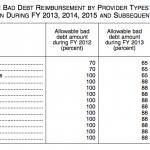It’s old news, but now it’s official. As of Oct. 1, Medicare bad debt reimbursement was cut to 65 percent.
The Centers for Medicare and Medicaid Services published the final rule earlier this month, detailing how the U.S. government will save almost $11 billion over 10 years (see chart below).
insidePatientFinance.com subscribers can download the final rules here: (You must be logged in to download this file. Don't have an account? Register for free and you'll be returned to this page.)
Most of the published rules focus on the prospective payment system (PPS) regulations for end-stage renal disease (ESRD) healthcare providers, but the section that affects almost every provider is reduction in bad debt reimbursement, which at a minimum will be 5 percent and will be as much as 35 percent over three years for some providers.
Congress passed the cut in bad debt reimbursement as part of February’s Middle Class Tax Relief and Job Creation Act of 2012. Prior to Oct. 1, Medicare reimburses healthcare providers anywhere between 70 and 100 percent of bad debt from eligible patients who fail to pay their deductible or co-pay bills. That percentage was cut to 65 percent, although for those healthcare providers who received reimbursements on 100 percent of bad debt will experience stair step cuts before reaching 65 percent in three years. By clicking on the thumbnail you can see by year how Medicare reimbursements for bad debt to specific provider groups will be cut:
[Click for larger image.]
Previously:






![[Image by creator from ]](/media/images/2015-04-cpf-report-training-key-component-of-s.max-80x80_F7Jisej.png)


![[Image by creator from ]](/media/images/New_site_WPWebinar_covers_800_x_800_px.max-80x80.png)
![[Image by creator from ]](/media/images/Finvi_Tech_Trends_Whitepaper.max-80x80.png)
![[Image by creator from ]](/media/images/Collections_Staffing_Full_Cover_Thumbnail.max-80x80.jpg)
![Report cover reads One Conversation Multiple Channels AI-powered Multichannel Outreach from Skit.ai [Image by creator from ]](/media/images/Skit.ai_Landing_Page__Whitepaper_.max-80x80.png)
![Report cover reads Bad Debt Rising New ebook Finvi [Image by creator from ]](/media/images/Finvi_Bad_Debt_Rising_WP.max-80x80.png)
![Report cover reads Seizing the Opportunity in Uncertain Times: The Third-Party Collections Industry in 2023 by TransUnion, prepared by datos insights [Image by creator from ]](/media/images/TU_Survey_Report_12-23_Cover.max-80x80.png)
![Webinar graphic reads RA Compliance Corner - Managing the Mental Strain of Compliance 12-4-24 2pm ET [Image by creator from ]](/media/images/12.4.24_RA_Webinar_Landing_Page.max-80x80.png)